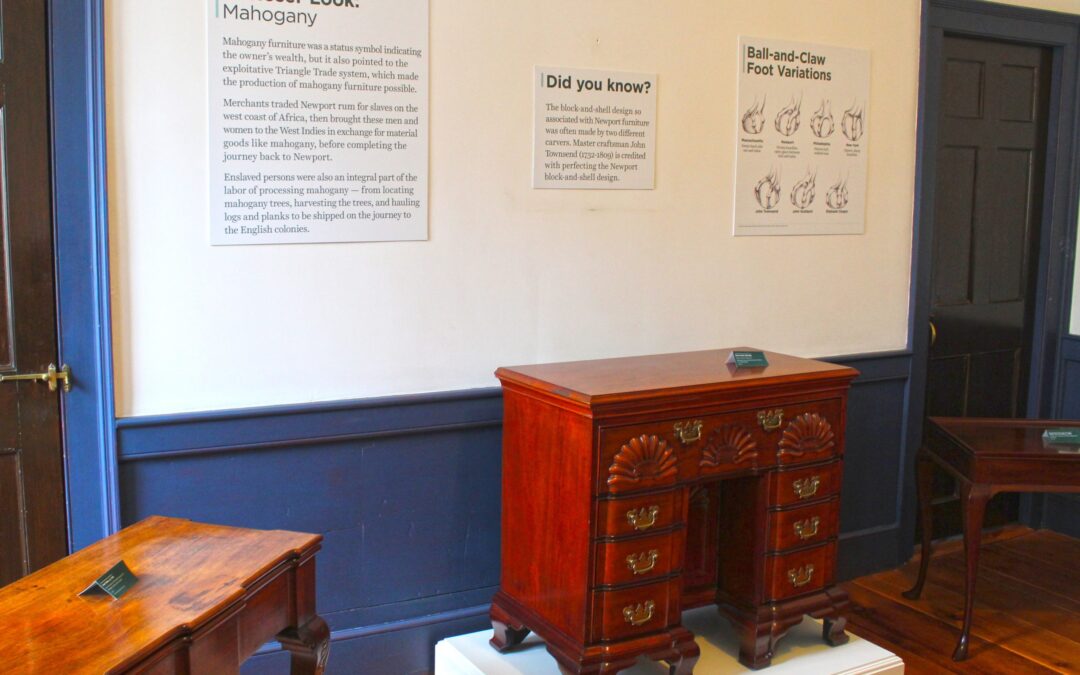
by NRF User | Jul 14, 2020 | NRF News
This year, we are celebrating the 20th anniversary of Rough Point Museum being open to the public, and this is the second year that the Whitehorne House Museum will be open to the public after a long period of rethinking and reinterpretation. This seemed like a good moment to reflect back on the work we’ve done and the work we aspire to do at both museums. The NRF interpretive team is responsible for the “who, what, where, when, and why” of the museum content guests encounter before, during, and after their visits. In other words, we are storytellers. Although we interpret the past, this work is not static, or frozen in time; it is an ongoing process of learning, reviewing, revising, and retelling.
We have been actively researching, learning, and listening (to our colleagues, to members of our community, and to people who have expertise beyond ours) in order to tell more inclusive, relevant, honest, and broader stories related to Rough Point, Doris Duke’s legacy, and colonial Newport.
At Whitehorne House Museum, we take a close look at the global systems of the 18th century and the role Newport furniture played in these systems. This is a complicated and sometimes painful history, but it allows us to tell a fuller story. By better understanding our past, we can better understand our present, and what to strive for in the future. Continued research—and the incorporation of different perspectives and voices—is part of the work we do to understand the process of making in cabinetmaking workshops, the division of labor in the production of furniture, the commissioning process, and the display and arrangement of furniture in domestic spaces.
One specific narrative concerns the African heritage men and women in Newport who—despite forced enslavement and systemic injustice—not only survived, but thrived and who made and continue to make significant contributions to the forming of Newport as a successful port city, and later a cultural tourist destination. Enslaved and free people of color were an integral part of many industries in 18th-century Newport, but more research needs to be done to learn about the role enslaved and free people of color had in the furniture industry.
At Rough Point, Doris Duke’s Newport home, we tell the story of her life and legacy. Newport remained a special place for Doris, and one of her most important contributions was the shaping of its historic cityscape through the preservation and restoration of 18th century vernacular (or every day) colonial buildings, as well as her contributions to the cultural heritage sector today through her decision to leave her home and fine and decorative arts collection open and accessible for public enjoyment.
But Rough Point was also the home of other women and men who helped care for and maintain the estate and ensured the estate ran smoothly and efficiently—and their stories are important too. We incorporate the literal voices of former caretakers in our museum tours, exhibitions, and programs. For example, our recent research has enabled us to tell the story of Hulda Goudie (1884-1983), a cook who worked for nearly half a century in the Duke households.
This year’s exhibition, “Beyond Fortune: Myths & Truths of Doris Duke” is an example of listening to our visitors. In our 2019 exhibit we asked visitors what they wanted to know more about in regards to Doris, her family, and Rough Point. Answers are incorporated throughout the exhibition. In addition, we are routinely doing research on objects in the collection of Rough Point and Whitehorne as more scholarship becomes available. This includes doing archival research at Duke University and seeking out similar items in other museum and private collections that can help us learn more about the objects we have. Much of this research has centered on where and how Doris Duke collected and decorated at Rough Point, which has provided many insights into the layered, personal approach to her choices.
Lastly, this year we are also commemorating the 100th anniversary of the 19th amendment to the U.S. constitution, which guaranteed women citizens the right to vote. A selection of objects at Rough Point and Whitehorne House Museum look closely at the stories of women: as craftspeople, artists, laborers, “keepers” and collectors—and how women have shaped our contemporary ideas of culture, history, and heritage.
As we move into the next decade, we will continue to research, explore, and collaborate with others to uncover more stories that are a part of the broader narrative we tell at Rough Point Museum and Whitehorne House Museum. We know that there is more thoughtful work that needs to be done to incorporate the histories and contributions of those whose stories are not as well-known but who should be, including voices of people of color (in particular African heritage, Rhode Island Indigenous, and Latinx voices), domestic workers, women, and LGTBQ+ histories. We will continue to revise and reshape the ways we think about objects, history, memory, and legacy, in order to create more meaningful, relevant, and accessible experiences. We hope you will join us, either onsite at the museums or virtually from your own home, as we continue to explore and share more stories.
By Gina Tangorra, Interpretation & Visitor Experience Manager, and Kristen Costa, Curator

by NRF User | Jun 12, 2020 | NRF News
Click here to watch Mandy Howe as she takes us into the apple orchard at Prescott Farm to demonstrate how we can make fun artwork from apples at home!
Here are the instructions for making your own nature art!
Materials:
- Fruits, vegetables, plant leaves (Almost any type of food or plant can be used to make a great print)
- Newspaper
- Paint (tempura, block print, etc.)
- Roller/brayer or paintbrushes
- Plate, tray, or recycled materials to hold pain
- Paper to print on
Instructions:
- Lay out newspaper to protect your work surface
- If printing with food, prepare the food by cutting it horizontally, or cutting the foods into shapes. You can cut apples horizontally to get a star shape in the middle, or citrus to see the design on the inside.
- Pour paint onto tray or plate, and roll out if needed.
- Dip the foods or leaves into the paint, and use roller or paintbrush to completely cover its surface if needed
- Press the food or leaf onto the paper.
- Experiment by using different patterns and colors, as well as different textures and colors of paper to print on.
- You can print on fabric if you use acrylic or fabric paints, to make a T-shirt, pillowcase, hat, apron, etc.
Don’t forget to share your artwork with us by tagging us on social media @nptrestoration!
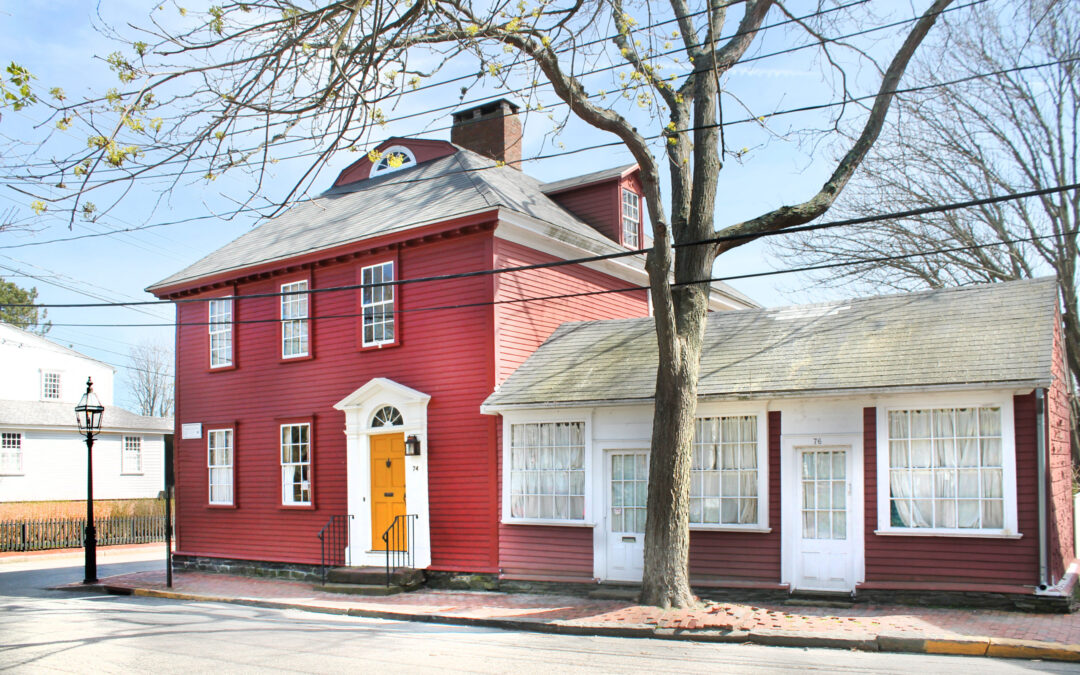
by NRF User | Jun 12, 2020 | NRF News
Dear Newport Restoration Community:
Summer is finally upon us here in Newport and our team is looking forward to reopening our museums to guests again very soon. Our Preservation Department has also been tackling the preservation and maintenance of our properties while adhering to a new set of COVID-19 protocols to ensure their health and safety as well as that of our tenant-stewards.
As part of our ongoing efforts to effectively manage our real estate portfolio, we are listing one of our properties, 74 Bridge Street. While it’s unusual for us to sell a property, it is something we do occasionally consider in the context of our overall portfolio, which includes over 70 historic homes. NRF, and other partner organizations, have gained knowledge from the home related to historic renovations, historic structures and sea level rise that will inform our work moving forward. We are requiring that the home be sold with an exterior easement attached to preserve the historic integrity of the property and the neighborhood. We are confident that we will find the right fit in a new owner.
If you have any further questions, please see the question and answer section below.
We look forward to seeing you soon.
Thank you,
Mark Thompson,
Executive Director
Q & A
Why is NRF selling 74 Bridge Street?
After NRF acquired the home, we used it to gain further knowledge on historic renovations, historic structures and sea level rise that will inform our work moving forward. We have made some upgrades to the home, such as a new roof, driveway, heating elements and others. With the additional upgrades needed for the home and current mortgage, the property does not fit into our rental model. We have worked with students to document the history of the property through archival research, architectural photography, and measured drawings, and NRF is requiring that the home be sold with an exterior easement attached to preserve the integrity of the property and the neighborhood. We are confident that we will find the right fit in a new owner.
How do the plans for 74 Bridge Street fit into NRF’s broader goals and real estate portfolio?
NRF is a preservation organization that has preserved over 80 buildings on Aquidneck Island, most of them in Newport and all of them historic. From time to time, we sell properties. Although, our staff and Board have discussed some program-related uses and rental in the past, it makes sense at this time for us to sell 74 Bridge Street. We will continue to protect the historic integrity of the home by requiring an exterior easement on the home which must be honored by future owners.
Is flooding, or climate-related effects, in the area a factor in selling the property?
Our decision to sell the house is unrelated to the flooding in The Point neighborhood. The house has provided valuable insight for studies conducted by us and others regarding historic structures and sea level rise. In addition, R.I. School of Design, with the assistance of NRF and the van Beuren Charitable Foundation, held a one-day exhibition at 74 Bridge Street using AR/VR technology to propose potential solutions for the future of the Point neighborhood in the context of sea level rise. We are proud to have had a property that was able to contribute to the conversation and teach us valuable lessons on this topic.
As the owners, NRF made flood-related updates to the home, such as relocating electrical panels, the boiler, and the hot water heater from the basement to the first floor. We also added sump pumps and a water detection alarm system that activates when water enters the basement.
Has COVID-19 affected NRF’s efforts? Is that why 74 Bridge St. is being sold?
NRF has thoroughly reviewed the decision to sell the Bridge Street property. The sale was approved by the Board in December 2019. While COVID-19 has had an effect on our ability to host in-person meetings and events, it was not a factor in the decision to sell one of our properties.
Is NRF selling any other homes in The Point neighborhood?
NRF currently owns 24 other historic houses in the Point with no current plans to sell any of them. In addition, we continue to stay up to date and involved in the conversation around climate related and flood prevention efforts in the area.
What has NRF done to protect its homes in The Point from climate change and flooding?
The threat of increased flooding is a unique and difficult problem that, especially in the case of historic structures, requires a sophisticated solution. We have been learning more about the steps other cities and organizations are taking to counteract the threat and working with consultants to learn more about the specific nature of the problem in Newport. We are also working with other entities, such as the City of Newport where appropriate, to develop solutions. These efforts recently include providing comments on various drafts of the guidelines for elevating houses recently passed by the City Council. It is important that the steps we take make sense in the context of the overall response.
How will this impact NRF’s climate change initiative?
This sale will have no impact on NRF’s commitment to its climate change initiative. We learned quite a bit during the five years we owned the house, which is informing our climate change activities.
Our study on 74 Bridge Street published for the public continues to be utilized here in Newport and around the country. We have sponsored and participated in five Keeping History Above Water conferences or workshops: Newport (2016); Annapolis (2017); Palo Alto (2018); St. Augustine (2019); and Nantucket (2019). The next Keeping History Above Water conference will take place in Charleston in March 2021. NRF is also currently working to bring the contemporary art project, “In the Waves” by Melissa McGill, to Rough Point in 2021 in an effort to raise awareness about sea level rise.
Where can I find the listing?
Click to here for the property listing.
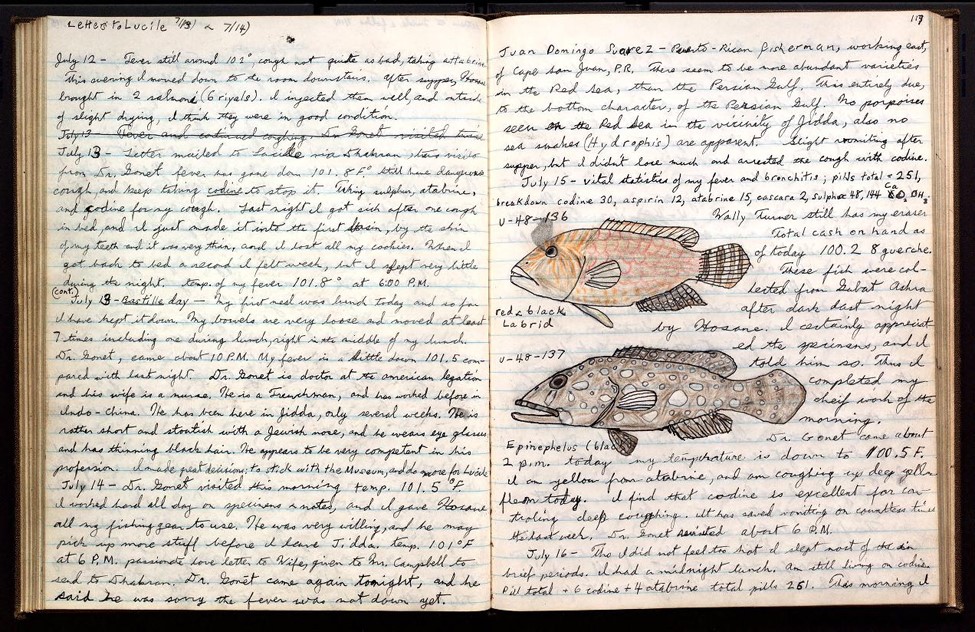
by NRF User | Jun 11, 2020 | NRF News
A field journal is important to the work of scientists who study nature, and they’re pretty fun to make too!
When you go outside and see nature (or even if you see plants and animals inside), you can record what you see and notice in your field journal. It is a way of keeping track of all the interesting things you observe in the world around you.
You can make a field journal however you want—out of an old notebook, loose paper, or maybe even a notebook from the Newport Restoration Foundation store!
There is no one way to make a field journal. You can record your observations in the way that makes the most sense to you. You can use writing, drawing, charts, pictures, or any other way you want to record your thoughts! Many scientists like to record the date, time, place, and weather conditions (is it sunny, cloudy, warm, windy, snowing?) on each page—this helps them to remember where and when they saw the plant or animal. If you want, you can also include an image of what you see—this can be a simple drawing, a colorful sketch, or even a photograph. Your observations can be written short, long, or anywhere in-between—just write about whatever interests you, and the things you’d like to remember about what you’re seeing.
It’s important to remember to try not to disturb the plants or animals as you are observing them, and to try to “leave no trace” to avoid hurting a plant or animal’s natural home or habitat.
Prescott Farm is a great place to get started on a field journal, since there are so many different plants and animals to see, all in one place!
Here are some examples of field journals, to help you get started:
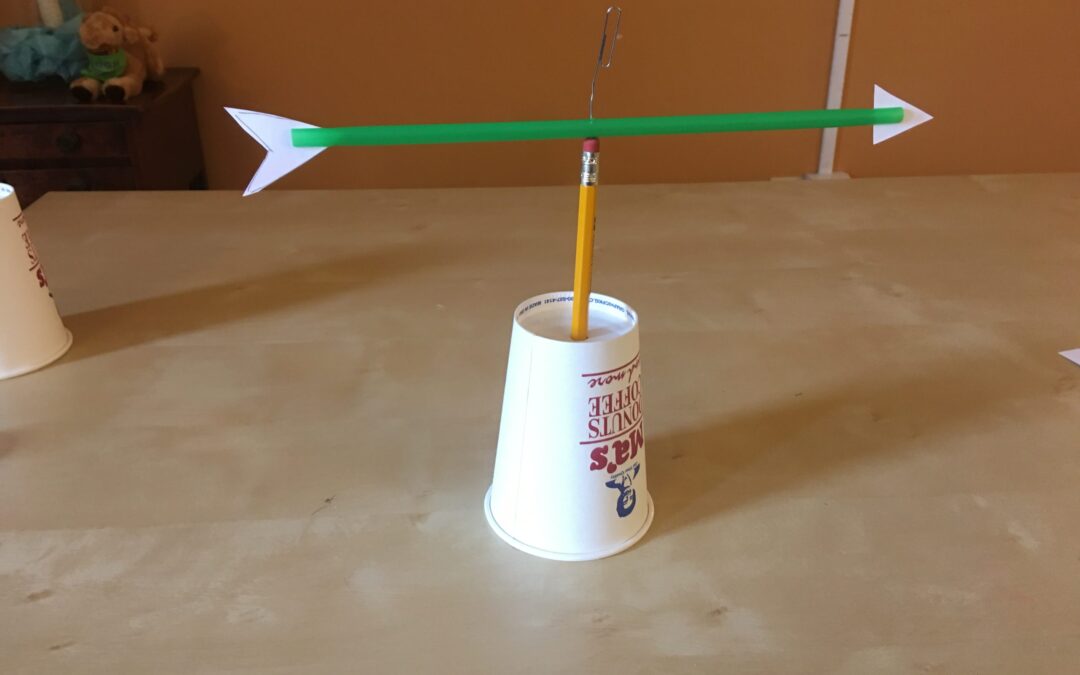
by NRF User | May 12, 2020 | NRF News
We learned about the Power of Wind from our May Second Sunday From Home program (Click here to check it out!). Now it’s time to learn how to create your own weather vane!
Instructions
Supplies:
– straw
– Pin or paper clip
– Pencil with eraser
– Cardstock (or heavier) paper
– Paper cup
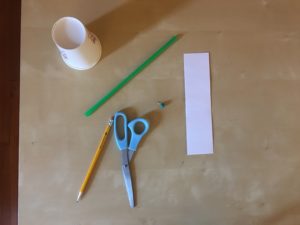
Step 1
Draw arrows on cardstock paper and cut out. Try to make the back arrow slightly larger than the front, this will help the weather vane point in the right direction (the bigger side will be pushed by the wind, so the smaller side will point in the direction the wind is blowing).
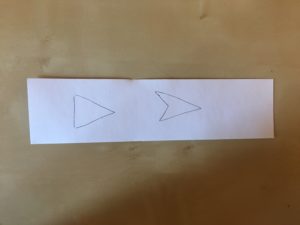
Step 2
Cut slits into ends of straw. Make sure your cuts are done in the same direction, or your arrows will not be aligned.
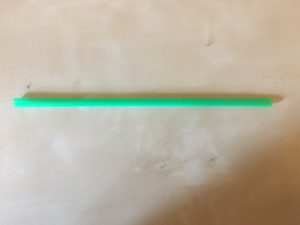
Step 3
Insert paper arrows (head and tail) into the ends of straw.
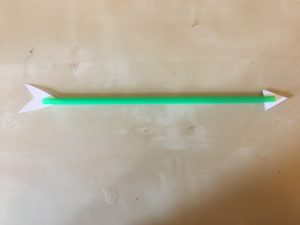
Step 4
Poke pencil into center of the bottom of the paper cup, or another household object (such as a paper box, a piece of clay, anything that will keep the pencil upright).
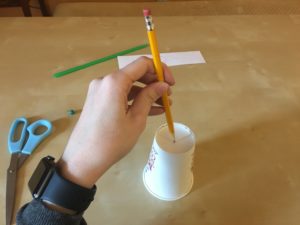
Step 5
Attach straw to the eraser using pin or paper clip. Make sure that your straw is able to turn smoothly.
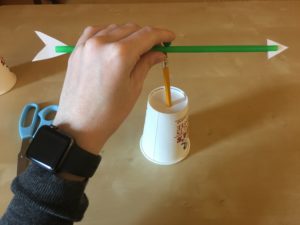
Step 6
Bring outside and watch it turn!
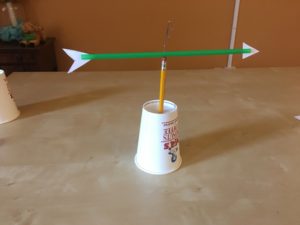
(Optional)
If you would like, use a compass to determine north, south, east, and west, and mark them on your weather vane. Now you’ll always know the direction of the wind!
Feel free to color or decorate your weather vane however you choose!
Be sure to share your weather vanes with us by tagging NRF on social media @nptrestoration!
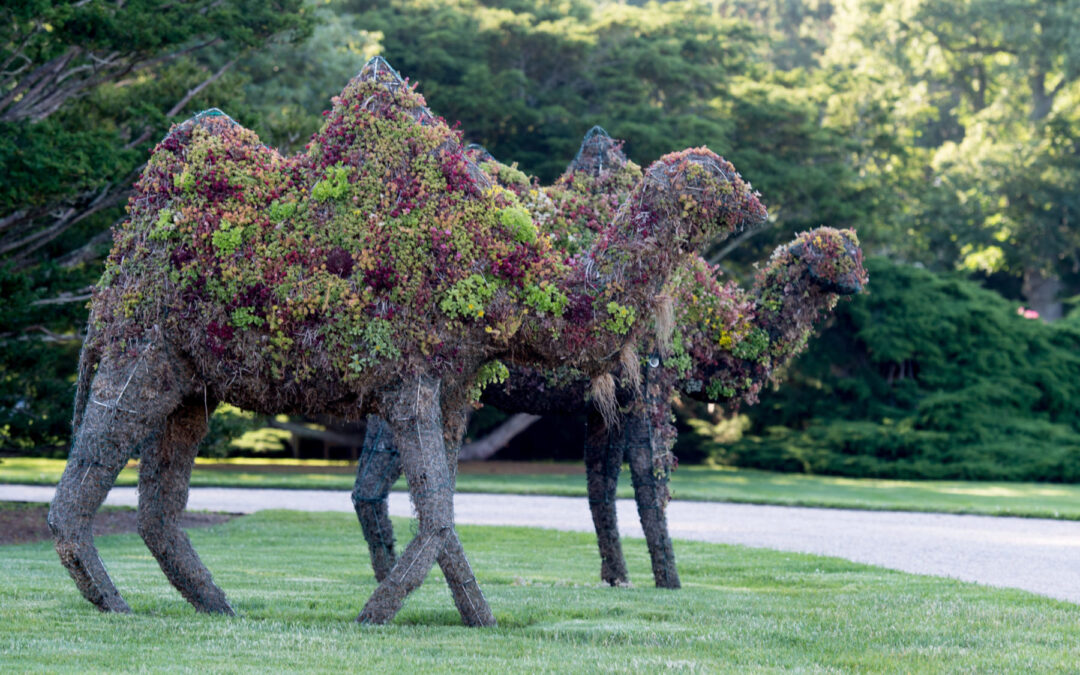
by NRF User | Apr 9, 2020 | NRF News
Between 1988 and 1992, Doris Duke’s camels Princess and Baby spent their summers at Rough Point in Newport. Today, you can still find camels at Rough Point — made out of plants!
Our talented grounds and gardens crew adds new plants to the sculptures every year, so they never look exactly the same. Now you can try your hand at decorating your own camel, and when we reopen check out how Princess and Baby are dressed this year!
Instructions:
Step 1 – Download a Camel Template, or draw your own!
Step 2 – Gather your supplies (whatever you can find!)
Step 3 – Create a masterpiece. Be as creative as you’d like! Perhaps even add plant materials to make your creation even more like our plant sculptures
Step 4 – Share your work of art with us on social media using the hashtag #camelcreations and tagging us @nptrestoration!
Templates:
Click here for Camel Template













